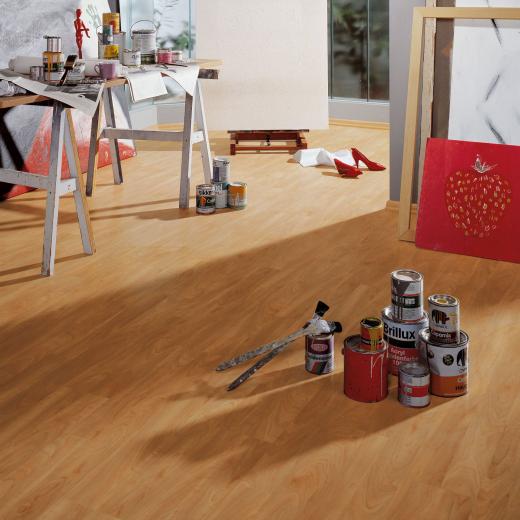Laminate flooring and the Ottomans . . . Or: Old technologies in new clothes
28 August 2006
In these times of personalized living space, laminate flooring ranks as one of the most versatile floor coverings ever. But it has a long history and goes right back to the days of the Ottomans. You didn't know that? The Ottomans and after them the Arabs used a technology that can now be regarded as the forerunner of the laminate process. They impregnated their paper, which arrived into the Orient from China with vegetable or animals fats, so that it would keep for longer and improve its writing quality. However, the arrival of modern laminating technology into the world was only at the start of the 20th century, when cellophane was invented, and people began to cover paper and other materials with this transparent material.
We know why they did it. For the Ottomans as well as for all those civilizations that came after them, it's about protecting and stabilizing paper. However, over the centuries, the technology has changed radically. Today we use a special laminating machine to cover our paperwork. Under pressure and at high temperatures, paper is shrink-wrapped into a plastic film pocket, rendering it dirt and water-resistant. You can laminate identity cards, menus, maps, posters, brochures, operating instructions, card games, bookmarks, paperback books and many more objects. Alongside its protective function, laminating fulfils the purpose of refining a piece of paper or other material, as you can achieve specific color or gloss effect when film, e.g. a gold or silver film, is applied.
It was in the middle of the 20th century that the first workable boards were developed and the European furniture industry began to exploit the new laminating technology, using it first for front panels and work surfaces. Decorative papers were impregnated with a special resin – on the one hand to protect the paper, but also to be able to process it further. At high pressure and temperature, the decorated paper was either pressed directly onto the core layer or glued to it in the form of pre-processed high-pressure laminated material. It’s at this point in history that the term laminate appears for the first time, which over time has come to be used for the high-pressure layered material. So the term laminate means nothing more than layers pressed together, with the top layer of course providing a particular type of protection or refinement.
The advent of laminate flooring
From here on in, it’s a small step to the introduction of laminate flooring. But it took almost another 30 years before laminates began to be used for flooring. As well as improving the boards, which form the core layer, it was necessary to develop the abrasion resistance of the resins, as floors have to cope with far greater demands than furniture surfaces. At the end of the 1980s, the first laminate floors came onto the market from Sweden and quickly took hold as far as Central Europe. This new type of flooring couldn't fail to grab the consumers' attention, as it came in attractive designs, was hardwearing, easy to fit and great value for money. As with every product, laminate flooring had its teething problems in the early years – but today it’s become a technically sophisticated floor covering product, which has posted rates of growth consistently over the years.
With glueless fitting technology, footstep soundproofing, water-repellent edge-finishing and many additional features, such as anti-static and anti-bacterial surfaces, laminate flooring is up there among the trendsetters in floor coverings. The latest synchronized grain and pore printing system allows totally authentic laminate flooring designs to be manufactured – in wood, stone and any other visual effects for that matter that might be in demand. It even recreates perfectly the natural structure of the material - touch the surface and you can actually feel the wood! As well as the decorative paper, it’s the melamine resin overlay that plays a key role in the creation of laminate flooring. This is the layer that achieves the special surface effects by means of its individual consistency, color rendition and/or imprint. It’s the refinement of the product.
The next generation has already arrived
Evolution doesn’t stand still. In the meantime, alongside existing laminate flooring which is layered and pressed using melamine resin, there are now those, which are design-printed directly onto the core layer which is then lacquered. Technologically speaking, it ushers in a new generation of laminate floorings and creates yet another new look and feel for floors. It’ll be fascinating to see where the history of laminate flooring takes us next. It goes back a long way, but we can be sure it’ll stay true to its creative roots well on into the future.
Contact for press enquiries
Anne-Claude Martin
Press Officer
press(at)eplf.com
Rue Defacqz 52
B - 1050 Ixelles
Phone +32 2 788 31 68
